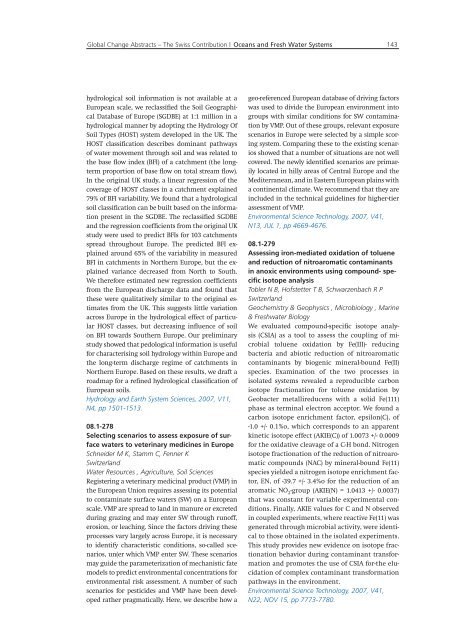Global Change Abstracts The Swiss Contribution - SCNAT
Global Change Abstracts The Swiss Contribution - SCNAT
Global Change Abstracts The Swiss Contribution - SCNAT
You also want an ePaper? Increase the reach of your titles
YUMPU automatically turns print PDFs into web optimized ePapers that Google loves.
<strong>Global</strong> <strong>Change</strong> <strong>Abstracts</strong> – <strong>The</strong> <strong>Swiss</strong> <strong>Contribution</strong> | Oceans and Fresh Water Systems<br />
hydrological soil information is not available at a<br />
European scale, we reclassified the Soil Geographical<br />
Database of Europe (SGDBE) at 1:1 million in a<br />
hydrological manner by adopting the Hydrology Of<br />
Soil Types (HOST) system developed in the UK. <strong>The</strong><br />
HOST classification describes dominant pathways<br />
of water movement through soil and was related to<br />
the base flow index (BFI) of a catchment (the longterm<br />
proportion of base flow on total stream flow).<br />
In the original UK study, a linear regression of the<br />
coverage of HOST classes in a catchment explained<br />
79% of BFI variability. We found that a hydrological<br />
soil classification can be built based on the information<br />
present in the SGDBE. <strong>The</strong> reclassified SGDBE<br />
and the regression coefficients from the original UK<br />
study were used to predict BFIs for 103 catchments<br />
spread throughout Europe. <strong>The</strong> predicted BFI explained<br />
around 65% of the variability in measured<br />
BFI in catchments in Northern Europe, but the explained<br />
variance decreased from North to South.<br />
We therefore estimated new regression coefficients<br />
from the European discharge data and found that<br />
these were qualitatively similar to the original estimates<br />
from the UK. This suggests little variation<br />
across Europe in the hydrological effect of particular<br />
HOST classes, but decreasing influence of soil<br />
on BFI towards Southern Europe. Our preliminary<br />
study showed that pedological information is useful<br />
for characterising soil hydrology within Europe and<br />
the long-term discharge regime of catchments in<br />
Northern Europe. Based on these results, we draft a<br />
roadmap for a refined hydrological classification of<br />
European soils.<br />
Hydrology and Earth System Sciences, 2007, V11,<br />
N4, pp 1501-1513.<br />
08.1-278<br />
Selecting scenarios to assess exposure of surface<br />
waters to veterinary medicines in Europe<br />
Schneider M K, Stamm C, Fenner K<br />
Switzerland<br />
Water Resources , Agriculture, Soil Sciences<br />
Registering a veterinary medicinal product (VMP) in<br />
the European Union requires assessing its potential<br />
to contaminate surface waters (SW) on a European<br />
scale. VMP are spread to land in manure or excreted<br />
during grazing and may enter SW through runoff,<br />
erosion, or leaching. Since the factors driving these<br />
processes vary largely across Europe, it is necessary<br />
to identify characteristic conditions, so-called scenarios,<br />
un(er which VMP enter SW. <strong>The</strong>se scenarios<br />
may guide the parameterization of mechanistic fate<br />
models to predict environmental concentrations for<br />
environmental risk assessment. A number of such<br />
scenarios for pesticides and VMP have been developed<br />
rather pragmatically. Here, we describe how a<br />
143<br />
geo-referenced European database of driving factors<br />
was used to divide the European environment into<br />
groups with similar conditions for SW contamination<br />
by VMP. Out of these groups, relevant exposure<br />
scenarios in Europe were selected by a simple scoring<br />
system. Comparing these to the existing scenarios<br />
showed that a number of situations are not well<br />
covered. <strong>The</strong> newly identified scenarios are primarily<br />
located in hilly areas of Central Europe and the<br />
Mediterranean, and in Eastern European plains with<br />
a continental climate. We recommend that they are<br />
included in the technical guidelines for higher-tier<br />
assessment of VMP.<br />
Environmental Science Technology, 2007, V41,<br />
N13, JUL 1, pp 4669-4676.<br />
08.1-279<br />
Assessing iron-mediated oxidation of toluene<br />
and reduction of nitroaromatic contaminants<br />
in anoxic environments using compound- specific<br />
isotope analysis<br />
Tobler N B, Hofstetter T B, Schwarzenbach R P<br />
Switzerland<br />
Geochemistry & Geophysics , Microbiology , Marine<br />
& Freshwater Biology<br />
We evaluated compound-specific isotope analysis<br />
(CSIA) as a tool to assess the coupling of microbial<br />
toluene oxidation by Fe(III)- reducing<br />
bacteria and abiotic reduction of nitroaromatic<br />
contaminants by biogenic mineral-bound Fe(II)<br />
species. Examination of the two processes in<br />
isolated systems revealed a reproducible carbon<br />
isotope fractionation for toluene oxidation by<br />
Geobacter metallireducens with a solid Fe(111)<br />
phase as terminal electron acceptor. We found a<br />
carbon isotope enrichment factor, epsilon(C), of<br />
-1.0 +/- 0.1%o, which corresponds to an apparent<br />
kinetic isotope effect (AKIE(C)) of 1.0073 +/- 0.0009<br />
for the oxidative cleavage of a C-H bond. Nitrogen<br />
isotope fractionation of the reduction of nitroaromatic<br />
compounds (NAC) by mineral-bound Fe(11)<br />
species yielded a nitrogen isotope enrichment factor,<br />
EN, of -39.7 +/- 3.4%o for the reduction of an<br />
aromatic NO 2-group (AKIE(N) = 1.0413 +/- 0.0037)<br />
that was constant for variable experimental conditions.<br />
Finally, AKIE values for C and N observed<br />
in coupled experiments, where reactive Fe(11) was<br />
generated through microbial activity, were identical<br />
to those obtained in the isolated experiments.<br />
This study provides new evidence on isotope fractionation<br />
behavior during contaminant transformation<br />
and promotes the use of CSIA for-the elucidation<br />
of complex contaminant transformation<br />
pathways in the environment.<br />
Environmental Science Technology, 2007, V41,<br />
N22, NOV 15, pp 7773-7780.

















